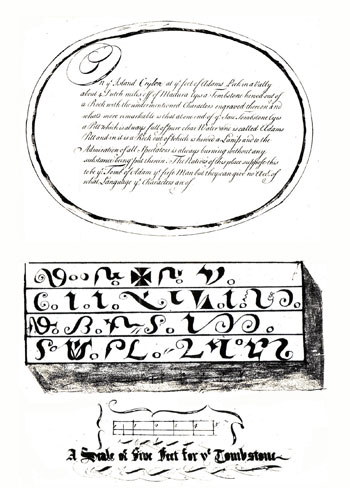
| The Mulgirigala mystery While the text reveals some clues, the inscription which includes a cross arouses much curiosity After the publication of my book Knox’s Words in 2004, a bibliophile presented me with a copy of a strange single-page document. It had fallen out of his first edition of Knox (1682), and he hoped that I might shed some light on its origin. The upper half of the sheet consists of a boldly encircled paragraph in English in the calligraphy and spelling typical of the seventeenth and eighteenth centuries, with the use of “ye” for “the” (although “ye” was used well into the 19th century) and capitals for the first letter of significant words. The lower half consists of a rendering of four rows of curious inscription atop a large tombstone, a scale of which, elaborately bordered, is appended beneath. The scale reveals the tombstone was 14ft long and 5ft wide. The text reads as follows: “On ye Island Ceylon at ye foot of Adams Peek in a Vally about 4 Dutch miles off of Madura lyes a Tombstone hewed out of a Rock with the undermentioned Characters engraved thereon and what’s more remarkable is that at one end of ye said Tombstone lyes a Pitt which is always full of pure clear Water and is called Adams Pitt and in it is a Rock out of which is hewed a Lamp and to the Admiration of all Spectators is always burning without any substance being put therein. The Natives of this place suppose this to be ye Tomb of Adam ye first Man but they can give no Account of what Language ye Characters are of.” It is evident that “Madura” refers to Matura, the south coast town now called Matara, although still known by the old name through the term “Matura diamond”, a colourless zircon mined locally. As for “Adam’s Peek”, readers should not believe it refers to the Adam’s Peak - Sri Pada - for this was the name given by the Dutch to the rock of Mulgirigala and its Buddhist temple complex situated north east of Matara.
A Dutch soldier wrote in 1663, “One sees the image of Adam formed of earth, of remarkable size, lying on the hill”. So it was that the Dutch came to believe that Adam’s ashes were buried at Mulgirigala and that the large recumbent Buddha statue enshrined at the Raja Maha Viharaya represented Adam. Because the Dutch started to call Mulgirigala by the name Adam’s Berg (or hill), it came to be confused with Sri Pada. It was not until 1766 that Governor Iman Willem Falck realized the Dutch muddle surrounding Mulgirigala and dropped the name Adam’s Berg. Therefore, the text seems likely to have been written prior to 1766 or possibly a little thereafter, allowing time for the name change to take effect. Whether it originated in English or was a translation from the Dutch cannot be determined. So it appears the tombstone reflects the Dutch belief in Mulgirigala as the resting place of Adam. But instead of being situated precisely at Mulgirigala, the tomb, according to the text, lay in a valley at the foot of the rock. It is extraordinary that, as far as I am aware, none of the prominent Dutch writers on Ceylon such as François Valentijn and Johann Wolfgang Heydt mention this tombstone, though they write of Mulgirigala in detail. Nor does the painter Arent Jansen, who stayed at the foot of Mulgirigala for several days in the 1730s while completing six drawings of the rock.The alleged distance of the tombstone (Mulgirigala) from Matara is of interest. A Dutch or “Hollandic” mile, a measurement that survived until 1820, was roughly 6km, so the four Dutch miles referred to equal 24km. This is short of the actual distance between Matara and Mulgirigala, but not drastically so, especially considering the limitations of measurement at the time. While the text reveals some clues, the inscription is a different matter. There is, however, one symbol that stands out from the rest: the cross appearing in the top line. It is known as a cross pattée, a name derived from the fact that the shape of each arm was thought to resemble a paw (French patte). This cross, sometimes confused with the similar Maltese cross, was used by the Teutonic Knights, adopted by the Knights Templar after their official recognition, and associated with Crusaders or the Crusades. |
|| Front
Page | News | Editorial | Columns | Sports | Plus | Financial
Times | International | Mirror | TV
Times | Funday
Times || |
| |
Copyright
2006 Wijeya
Newspapers Ltd.Colombo. Sri Lanka. |
